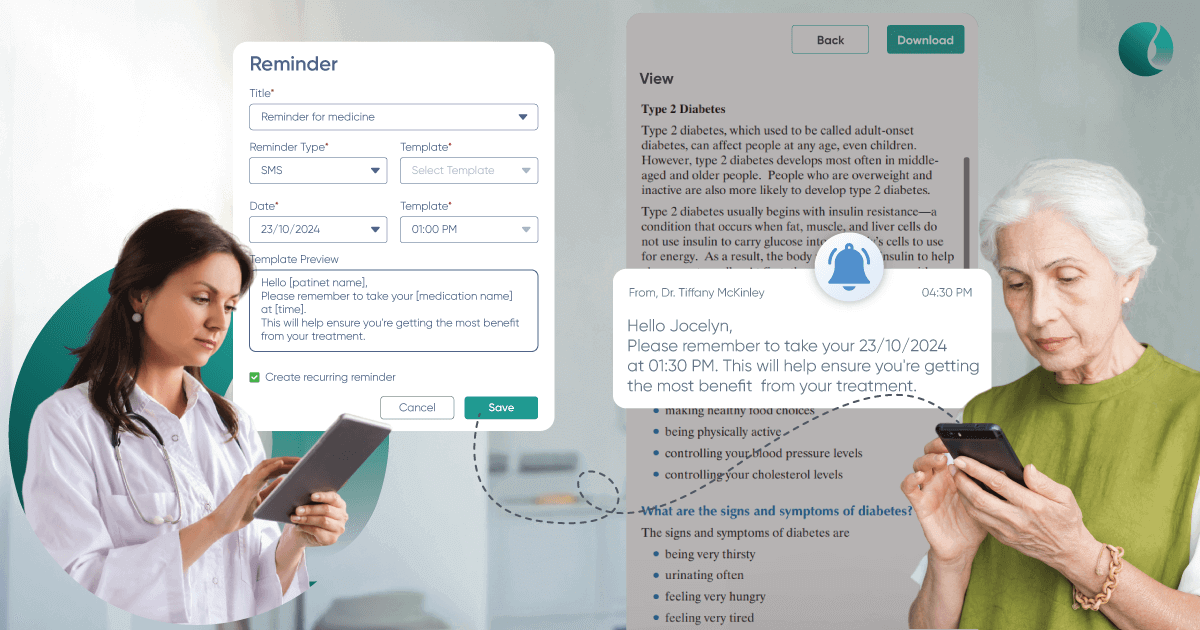Client Background
The client is a well-known healthcare practitioner in Florida who offers chronic care management services to patients in the primary care specialization. The client aspires to provide high-quality healthcare with compassion and medical knowledge. The client has a huge number of practice professionals working hard to improve patient health outcomes. The client was managing over 2000 patients using chronic care management software.
Business challenges
While managing patients with chronic conditions, the client has observed a huge count of patients from rural areas unable to take necessary treatment for chronic conditions because of unavailability of transportation facilities, difficulty in traveling due to health issues, and devices to track health vitals, etc. While administering the chronic care management program for numerous patients, the client has identified the need for ongoing monitoring of patient vitals to enhance care delivery and maximize reimbursement opportunities.
Some of the business challenges faced by the client are:
1. Accessibility Barriers for Rural Patients
Rural patients faced difficulties accessing necessary treatments for chronic conditions due to transportation limitations, health-related travel constraints, and lack of vital monitoring devices. This resulted in compromised healthcare outcomes for rural patients and hindered the client's efforts to deliver comprehensive care to all patients.
2. Need for Ongoing Patient Monitoring
The client identified the necessity for continuous monitoring of patient vitals to enhance care delivery and optimize reimbursement opportunities in their chronic care management program. Without ongoing monitoring capabilities, the client struggled to provide proactive care management and missed opportunities to maximize revenue through value-based care initiatives.
3. Lack of real-time patient health data
Before implementing remote monitoring solutions, the client faced challenges accessing timely and accurate patient health data. Without real-time insights into patient vitals and health trends, care providers struggled to make informed decisions and interventions, leading to potential delays in patient care and treatment adjustments.
4. Limited patient education resources
The client encountered difficulties providing comprehensive educational materials to patients regarding their chronic conditions and treatment plans. Due to resource constraints and logistical challenges, patients received limited information about their conditions, hindering their understanding of the importance of treatment adherence and lifestyle modifications.
Solution
To address the issue, the customer approached Medarch Inc. about eCareMD remote patient monitoring softwareplatform, which uses cutting-edge technology to provide effective care and improve patient health outcomes.
Our team of business analysts and subject matter specialists participated in several interactive conversations and demonstrations to better understand and meet the expectations of the client. After understanding the exact business challenge and customer requirements, our team implemented eCareMD software in the client's clinic. After implementation, the customer saw a significant rise in revenue and patient satisfaction.
Solution Highlights

The eCareMD software has various features that help deliver high-quality care to patients. Some of the features are:
1. Use of Smart Devices
Chronic illnesses require continuous attention and can be life-threatening or lead to health consequences if missed. Patients can obtain vital readings from home and track their health changes using smart devices such as glucose meters, pulse oximeters, and blood pressure monitors. These devices can be assigned to patients and integrated with the eCareMD software.
Bluetooth or Wi-Fi connects the devices, and the collected health data is effortlessly shared with the care provider's eCareMD software in less than a second.
2. Secure Communication Channels
Interaction with patients is vital in remote patient monitoring since it keeps the patient on track with their treatment plan and reduces health issues. Communication channels such as chat, text message, and instant call features enable care providers to engage with patients as needed to complete tasks such as daily, weekly, and monthly chart reviews, prescription refills, and physician reviews. Patients can also communicate with healthcare providers about their vital signs and treatment options. This continuous interaction keeps patients motivated and adhere to their treatment plan, resulting in fewer hospital readmissions and emergency visits.
3. Clinical Data-based Decision Making
Remote monitoring devices continuously collect patient health data and transmit it to the care provider's eCareMD software. This collective, real-time patient health data enables care providers to view the trends and changes in patient health and helps them make informed decisions and interventions as required.
4. Send Educational material
The eCareMD software enables care providers to empower patients by sending educational material related to treatment and chronic conditions. This educational material helps patients understand chronic conditions, their impacts, and the benefits of adhering to the treatment plan. It also increases patient engagement and adherence to treatment plans.
Value Delivered
1. Increased Access to Care
Using eCareMD software, care providers can deliver chronic care management services to patients from rural areas using remote patient monitoring.
2. Improved Data Accuracy and Collection
Continuous collection and transmission of patient health data through remote monitoring devices increase data accuracy as it does not involve manual entries or intervention.
3. Reduction in Costs
Informed decision-making based on collected real-time clinical health data of patients and timely intervention by care providers reduces the need for readmission in hospital and emergency visits, thereby reducing the costs associated with it.
4. Increased patient engagement and treatment adherence
As the eCareMD software enabled care providers to send educational material to patients, it helped patients to know more about chronic conditions, lifestyle recommendations, the advantages of following the prescribed guidelines, etc.
It resulted in increased patient engagement with a treatment plan and treatment adherence.

